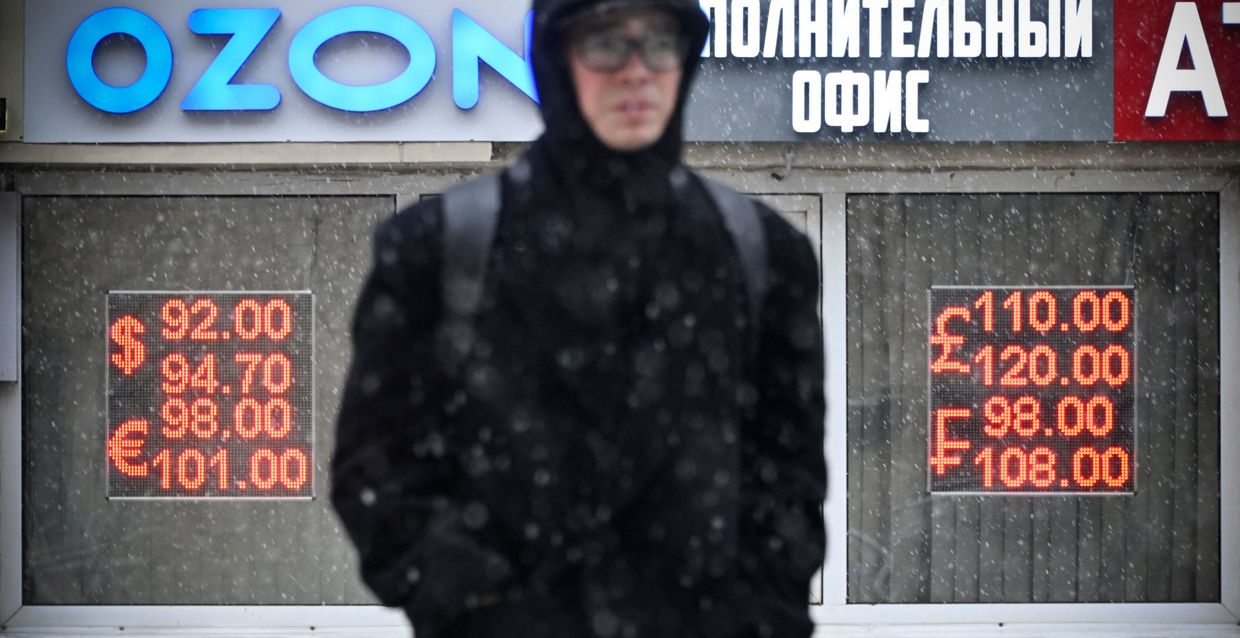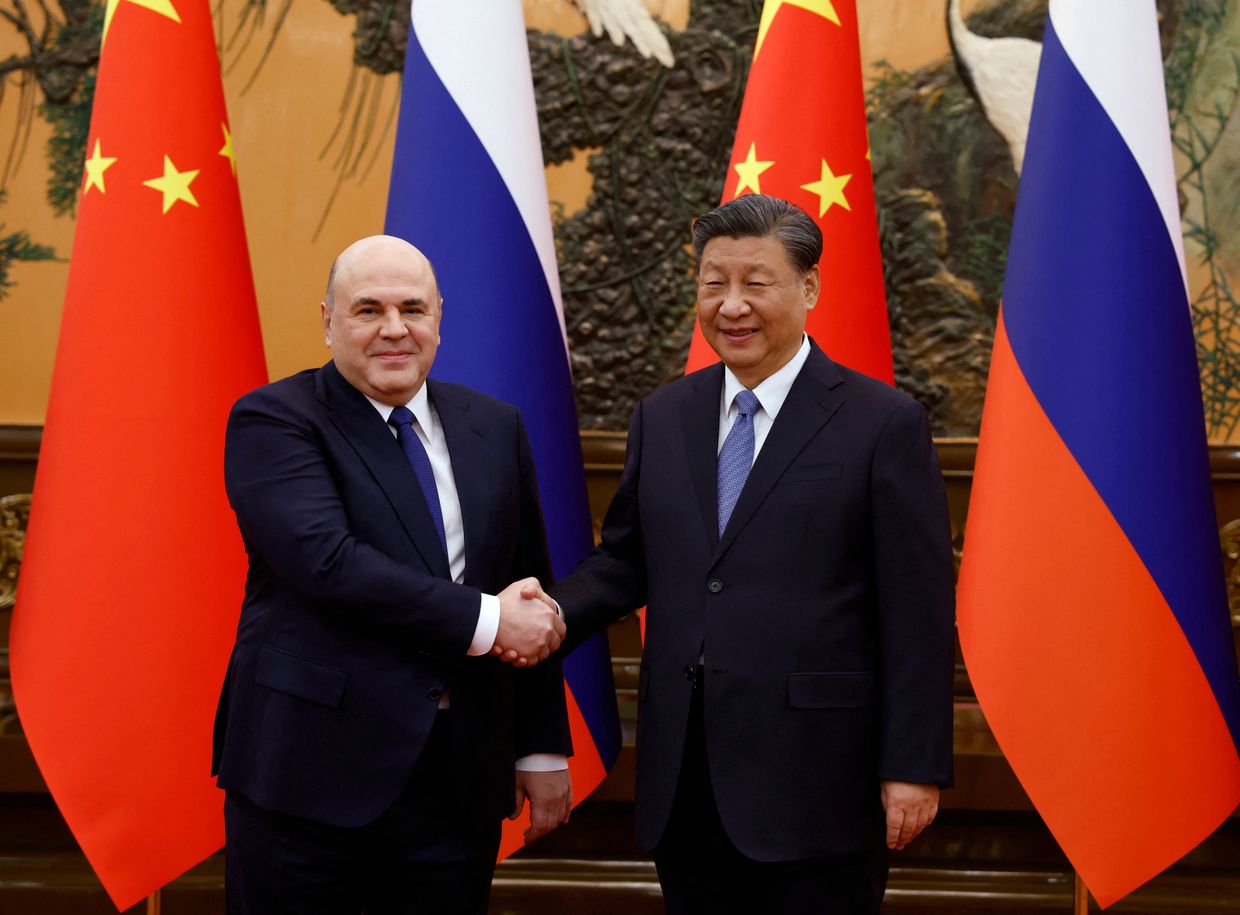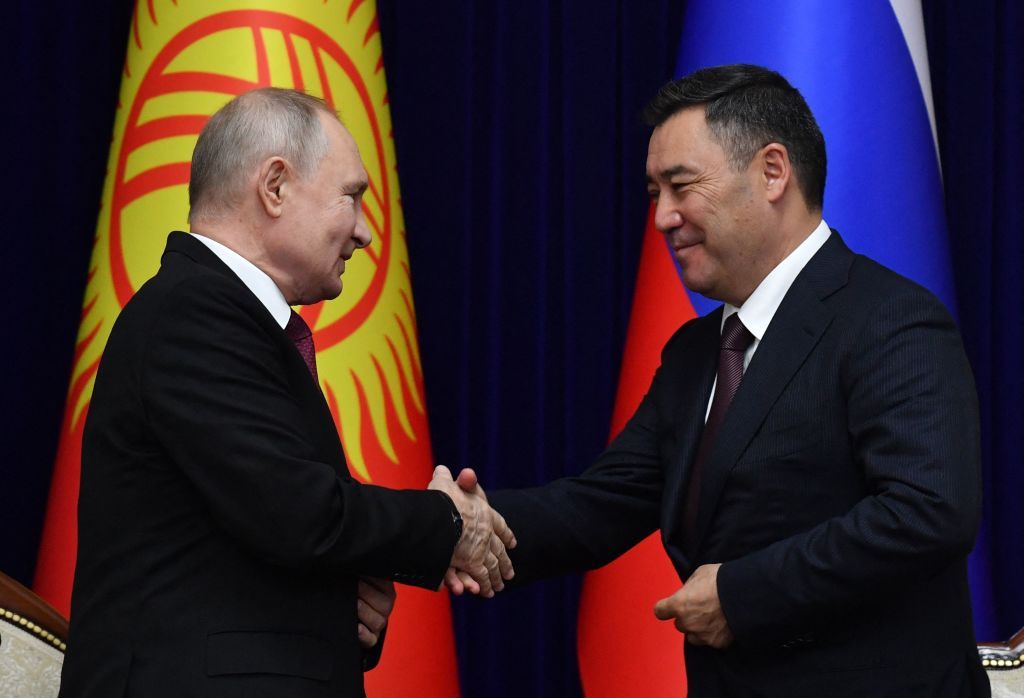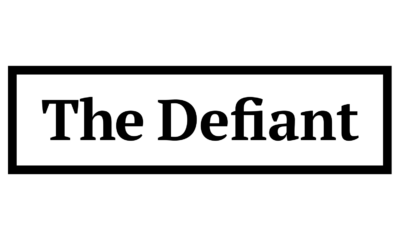News
Russia struggles to control finances as Ukraine invasion spending soars

Support independent journalism in Ukraine. Join us in this fight.
Become a member
Support us just once
Since the full-scale invasion of Ukraine began in 2022, the Russian government has focused all of its financial resources on funding the war.
As the war is the Kremlin’s number one priority, all tools at its disposal have been used: increased taxation, sovereign funds, domestic borrowing, and the printing of money.
So far, tax hikes and money issuance have been relatively moderate.
The economists at the helm of Russia’s financial system have tried to keep spending, money supply, and inflation under control. Two-and-a-half years in, this balancing act is becoming increasingly difficult.
A view of the Russian Central Bank headquarters in downtown Moscow on May 26, 2022. (Natalia Kolesnikova / AFP via Getty Images)
According to Russian political analyst Dmitry Oreshkin, Russia’s Central Bank Chief Elvira Nabiulina is trying to maintain a sound monetary policy but the war requires increasing expenses.
“Nabiulina faces a task that can’t be fulfilled,” Oreshkin told the Kyiv Independent.
Budget
As a result of the full-scale invasion, Russia’s spending on national defense rose from 3.6 trillion rubles ($51 billion) in 2021 to 6.4 trillion rubles ($75 billion) in 2023 and is expected to rise to 10.8 trillion rubles ($120 billion), or 29.4% of the budget, in 2024.
NATO countries have set a goal to spend 2 percent of the country’s GDP on defense in 2024. Russia is spending 6 percent.
In contrast, social spending is expected to amount to 7.7 trillion rubles ($87 billion), or 21.1% of the Russian budget in 2024.
Due to the soaring expenditures on the military, Russia has had problems balancing its budget.
Before the invasion, Russia’s federal budget had a surplus of 524 billion rubles ($7 billion), or 0.4% of GDP, in 2021.
However, Russia’s budget deficit totaled 3.295 trillion rubles ($47 billion), or 2.1% of GDP, in 2022, and 3.24 trillion ($38 billion), or 1.9% of GDP, in 2023. The budget deficit is expected to amount to 120.1 billion rubles ($1.38 billion), or 1.1% of GDP, in 2024.
As Russian tank losses in Ukraine continue to mount, here’s what you need to know
Russian losses in Ukraine recently passed another milestone, with the total number of “tanks” claimed destroyed by Kyiv passing the 8,000 mark. As of July 1, the figure stands at 8,099, according to the General Staff of Ukraine’s Armed Forces. At the start of the full-scale invasion, Russia

Taxes
One of the primary ways to fund the war is taxation.
From 2001 until 2021, Russia prided itself on having a flat income tax rate of 13%, which was a significant incentive for businesses.
In 2021, the Russian government introduced a 15% rate for income exceeding 5 million rubles ($57,000). A further and more dramatic change took place during the full-scale invasion of Ukraine.
In May 2024, Russia’s Finance Ministry announced plans to impose income tax rates ranging from 15% to 22% for income exceeding 2.4 million rubles ($28,000) starting in 2025.
Meanwhile, the corporate tax will rise from 20% to 25%, and reduced rates for some businesses will be canceled.
 A man walks past a currency exchange office in the snow in central Moscow on Oct. 27, 2023. (Alexander Nemenov /AFP via Getty Images)
A man walks past a currency exchange office in the snow in central Moscow on Oct. 27, 2023. (Alexander Nemenov /AFP via Getty Images)
The mineral tax for iron production will rise from 4.8% to 5.5%, while the mineral tax for fertilizer production will be doubled.
“The increase in taxes is indeed linked to spending on the war,” Andrei Movchan, a Russian-born economist based in London, told the Kyiv Independent.
He said that the tax hike threatened to undermine economic growth and would have a negative impact on the civilian sector.
“It will trigger inflation because the production of consumer goods is falling, while the state-stimulated demand for them remains the same,” Movchan, the founder of investment company Movchan’s Group, said.
Russian columnist Sergei Parkhomenko said the tax hike “is due to Putin’s regime’s need for money during wartime.”
“The corporate tax hike will affect everyone and will be very sensitive for Russian businesses,” he told the Kyiv Independent. “They need to finance both the war and social spending.”
However, the current tax hike is relatively moderate and contains many exceptions.
By comparison, income tax rates range from 10% to 37% in the U.S., from 0% to 45% in France, and from 32% to 52% in Sweden.
Higher income tax rates will apply not to the whole income but to its part exceeding the threshold. For instance, if someone earns 3 million rubles annually, he will pay 13% for the 2.4 million rubles below the threshold and 15% for the 600,000 rubles above the threshold.
 Russian military helicopters painted with the letter Z, a tactical insignia of Russian troops in Ukraine, are seen flying by a cemetery near a military airfield outside Taganrog in the Rostov region on July 26, 2022, amid the ongoing Russian military action in Ukraine. (Stringer / AFP via Getty Images)
Russian military helicopters painted with the letter Z, a tactical insignia of Russian troops in Ukraine, are seen flying by a cemetery near a military airfield outside Taganrog in the Rostov region on July 26, 2022, amid the ongoing Russian military action in Ukraine. (Stringer / AFP via Getty Images) Vladimir Putin attends a concert marking the eighth anniversary of Russia’s annexation of Crimea at the Luzhniki stadium in Moscow on March 18, 2022. (Mikhail Klimentyev /SPUTNIK/AFP via Getty Images)
Vladimir Putin attends a concert marking the eighth anniversary of Russia’s annexation of Crimea at the Luzhniki stadium in Moscow on March 18, 2022. (Mikhail Klimentyev /SPUTNIK/AFP via Getty Images)
Moreover, the new rates will not apply to income from securities and sole proprietorships, which will be subject to a rate of 13-15%, like before.
Parkhomenko described the progressive rate of income taxation, in contrast with the corporate tax hike, as “a propagandist measure that has little economic sense.”
“The Russian government wants to demonstrate that it’s just: ‘we take more from the wealthy and less from the poor because we care about the common folk’,” he said.
Another political analyst, currently based in Russia, agreed with this assessment, saying that the income tax hike for the wealthy could be a PR move aiming to show that the Kremlin cares for “social justice,” as well as a long-term plan to offset the drop in oil and gas revenues. The analyst spoke on condition of anonymity due to fear of reprisals.
He said that the current tax hike is moderate, but it could be a “test before a more radical tax reform.”
“If taxes are increased now, there is a risk that it may happen again,” Oreshkin said.
As Russian losses in Ukraine hit 500,000, Putin buries future demographic risks at home
According to Ukraine’s General Staff, over half a million Russian soldiers were either killed or wounded in Ukraine during the 27-month-long full-scale war. The staggering number is in line with the estimates of the U.K. and France, which said earlier in May that the overall Russian losses are set

Oil and gas
Historically, the Russian budget’s main source of revenue has been oil and gas.
Russia is still able to make money by selling oil and gas as a result of bypassing sanctions and boosting supplies to non-Western countries.
Following the full-scale invasion, the Russian government’s oil and gas revenues rose by 28% in 2022, according to Russian government data, as oil prices increased, while Western sanctions on the oil and gas industry were not in force during most of the year. According to Reuters, the Russian budget’s oil and gas revenues then fell by 24% to 8.822 trillion rubles ($103 billion) in 2023 amid lower prices and Western sanctions.
However, this year, Russia’s oil and gas revenues are increasing as the Kremlin re-oriented supplies to China and India, and prices are rising again.
 Russian Prime Minister Mikhail Mishustin and Chinese President Xi Jinping shaking hands prior to their meeting in Beijing on Dec. 20, 2023. (Dmitry Astakhov/POOL/AFP via Getty Images)
Russian Prime Minister Mikhail Mishustin and Chinese President Xi Jinping shaking hands prior to their meeting in Beijing on Dec. 20, 2023. (Dmitry Astakhov/POOL/AFP via Getty Images) Oil storage tanks stand illuminated at night at the RN-Tuapsinsky refinery, operated by Rosneft Oil Co., in Tuapse, Russia, on Sunday, March 22, 2020. (Andrey Rudakov/Bloomberg via Getty Images)
Oil storage tanks stand illuminated at night at the RN-Tuapsinsky refinery, operated by Rosneft Oil Co., in Tuapse, Russia, on Sunday, March 22, 2020. (Andrey Rudakov/Bloomberg via Getty Images)
The Russian government’s oil and gas revenue in June is set to rise by more than 50% year-on-year to $9.4 billion, according to Reuters. The Russian government expects oil and gas revenues to rise by 21% year-on-year to 10.7 trillion rubles ($120 billion) in 2024.
“Sanctions can’t be completely effective,” Ukrainian oil and gas analyst Oleksandr Kharchenko told the Kyiv Independent. “But there is an opportunity and a need to strengthen the impact of the sanctions.”
He said that one of the potential solutions is to reach an agreement with the biggest oil producers to sell more oil and cut prices, thus depriving Russia of revenues.
Kyrgyzstan’s trade is booming as Russia masters sanctions circumvention
In March 2022, Kyrgyzstan’s economy began to change. Imports from long-term trade partners started to steadily rise, with imports from China almost tripling. The shift was even more noticeable for countries that previously had few business ties to Bishkek. A sudden rush of goods appeared from acros…

Other methods
Russia has also used its National Wealth Fund to balance the budget and finance military spending.
The fund was created in 2008 to collect windfall oil revenues and create a safety cushion in case oil prices fall.
The State Duma, the Russian parliament’s lower house, said in 2023 that 1.3 trillion rubles ($15 billion) from the National Wealth Fund would be used to balance the budget in 2024.
Movchan said the fund is being used to finance military spending, among other things.
“Russia finances spending through internal borrowing and sovereign funds,” he said. “It increases the velocity of money and leads to inflation but does not lead to an increase in the money supply.”
Russia’s increasing domestic debt also reflects growing military expenditures.
The Russian government’s domestic debt rose from 16.5 trillion rubles ($220 billion) in early 2022 to 18.8 trillion rubles ($255 billion) in early 2023 to 20.99 trillion rubles ($240 billion) in March 2024.
Printing money
Another way to finance the war is for the country’s Central Bank to print additional money.
Russia’s money supply rose by 13% in 2021, but the growth rate was much higher after the full-scale invasion began – 24.4% in 2022. In 2023, it grew slower but still more than in the pre-war period – by 19.4%.
The increase in the money supply has fueled inflation, although currently its level is not higher than before the invasion, according to official data.
Consumer price inflation amounted to 8.39% in 2021, 11.94% in 2022, and 7.42% in 2023.
Russian economist Igor Lipsits believes that real inflation figures are higher than the official ones. Movchan shares the same belief.
Yet, Russia’s inflation rate is still far below the level of hyperinflation experienced by many countries in wartime and after wars. Ukraine’s inflation rate was worse in 2022: it amounted to 22.6%, according to official data. However, it improved in 2023, amounting to 5.1% – below the Russian level.
Lipsits and Oreshkin said that Russia’s Central Bank resorts to printing money more and more because of the war, fueling inflation.
“Any country succumbs to the issuance of more money and (boosting) inflation during war,” Oreshkin said.
Meanwhile, Movchan attributed the increase in Russia’s money supply to other factors, such as the recovery from COVID-19 and the necessity of stimulating money circulation in the economy.
After the invasion began, Russia’s Central Bank cut its key interest rate from 20% to 7.5%, introducing a more lax monetary policy and stimulating the printing of new money.
 Chairman of the Central Bank of Russia Elvira Nabiullina speaks during the session as a part of the St. Petersburg International Economic Forum (SPIEF) in St. Petersburg, Russia on June 6, 2024. (Sefa Karacan/Anadolu via Getty Images)
Chairman of the Central Bank of Russia Elvira Nabiullina speaks during the session as a part of the St. Petersburg International Economic Forum (SPIEF) in St. Petersburg, Russia on June 6, 2024. (Sefa Karacan/Anadolu via Getty Images)
However, since July 2023, the Central Bank has pursued a tight monetary policy that impedes printing money. The interest rate has been increased to 16%.
On June 7, the Central Bank said it would keep the rate at the current level and could even increase it further in the future.
Elvira Nabiullina, head of Russia’s Central Bank, is a free-market liberal credited with keeping Russia’s financial system sound even during the full-scale invasion.
She wants to minimize credit expansion and the issuance of new money but the needs of the war require a more lax monetary policy, according to Oreshkin.
He said that, as a result, Nabiullina could be dismissed.
“They might fire Nabiullina and appoint someone who’ll simply print (more) money,” he added.
News
Modiv Industrial to release Q2 2024 financial results on August 6

RENO, Nev., August 1, 2024–(BUSINESS THREAD)–Modiv Industrial, Inc. (“Modiv” or the “Company”) (NYSE:MDV), the only public REIT focused exclusively on the acquisition of industrial real estate properties, today announced that it will release second quarter 2024 financial results for the quarter ended June 30, 2024 before the market opens on Tuesday, August 6, 2024. Management will host a conference call the same day at 7:30 a.m. Pacific Time (10:30 a.m. Eastern Time) to discuss the results.
Live conference call: 1-877-407-0789 or 1-201-689-8562 at 7:30 a.m. Pacific Time Tuesday, August 6.
Internet broadcast: To listen to the webcast, live or archived, use this link https://callme.viavid.com/viavid/?callme=true&passcode=13740174&h=true&info=company&r=true&B=6 or visit the investor relations page of the Modiv website at www.modiv.com.
About Modiv Industrial
Modiv Industrial, Inc. is an internally managed REIT focused on single-tenant net-leased industrial manufacturing real estate. The company actively acquires critical industrial manufacturing properties with long-term leases to tenants that fuel the national economy and strengthen the nation’s supply chains. For more information, visit: www.modiv.com.
View source version on businesswire.com: https://www.businesswire.com/news/home/20240731628803/en/
Contacts
Investor Inquiries:
management@modiv.com
News
Volta Finance Limited – Director/PDMR Shareholding


Volta Finance Limited
Volta Finance Limited (VTA/VTAS)
Notification of transactions by directors, persons exercising managerial functions
responsibilities and people closely associated with them
NOT FOR DISCLOSURE, DISTRIBUTION OR PUBLICATION, IN WHOLE OR IN PART, IN THE UNITED STATES
*****
Guernsey, 1 August 2024
Pursuant to announcements made on 5 April 2019 and 26 June 2020 relating to changes to the payment of directors’ fees, Volta Finance Limited (the “Company” or “Volta”) purchased 3,380 no par value ordinary shares of the Company (“Ordinary Shares”) at an average price of €5.2 per share.
Each director receives 30% of his or her director’s fee for any year in the form of shares, which he or she is required to hold for a period of not less than one year from the respective date of issue.
The shares will be issued to the Directors, who for the purposes of Regulation (EU) No 596/2014 on Market Abuse (“March“) are “people who exercise managerial responsibilities” (a “PDMR“).
-
Dagmar Kershaw, Chairman and MDMR for purposes of MAR, has acquired an additional 1,040 Common Shares in the Company. Following the settlement of this transaction, Ms. Kershaw will have an interest in 12,838 Common Shares, representing 0.03% of the Company’s issued shares;
-
Stephen Le Page, a Director and a PDMR for MAR purposes, has acquired an additional 728 Ordinary Shares in the Company. Following the settlement of this transaction, Mr. Le Page will have an interest in 50,562 Ordinary Shares, representing 0.14% of the issued shares of the Company;
-
Yedau Ogoundele, Director and a PDMR for the purposes of MAR has acquired an additional 728 Ordinary Shares in the Company. Following the settlement of this transaction, Ms. Ogoundele will have an interest in 6,862 Ordinary Shares, representing 0.02% of the issued shares of the Company; and
-
Joanne Peacegood, Director and PDMR for MAR purposes has acquired an additional 884 Ordinary Shares in the Company. Following the settlement of this transaction, Ms. Peacegood will have an interest in 3,505 Ordinary Shares, representing 0.01% of the issued shares of the Company;
The notifications below, made in accordance with the requirements of the MAR, provide further details in relation to the above transactions:
|
a) Dagmar Kershaw |
b) Stephen LePage |
c) Yedau Ogoundele |
e) Joanne Pazgood |
|||
|
a. Position/status |
Director |
|||||
|
b. Initial Notification/Amendment |
Initial notification |
|||||
|
||||||
|
a name |
Volta Finance Limited |
|||||
|
b. LAW |
2138004N6QDNAZ2V3W80 |
|||||
|
a. Description of the financial instrument, type of instrument |
Ordinary actions |
|||||
|
b. Identification code |
GG00B1GHHH78 |
|||||
|
c. Nature of the transaction |
Acquisition and Allocation of Common Shares in Relation to Partial Payment of Directors’ Fees for the Quarter Ended July 31, 2024 |
|||||
|
d. Price(s) |
€5.2 per share |
|||||
|
e. Volume(s) |
Total: 3380 |
|||||
|
f. Transaction date |
August 1, 2024 |
|||||
|
g. Location of transaction |
At the Market – London |
|||||
|
The) |
B) |
w) |
It is) |
|||
|
Aggregate Volume: Price: |
Aggregate Volume: Price: |
Aggregate Volume: Price: |
Aggregate Volume: Price: |
|||
CONTACTS
For the investment manager
AXA Investment Managers Paris
Francois Touati
francois.touati@axa-im.com
+33 (0) 1 44 45 80 22
Olivier Pons
Olivier.pons@axa-im.com
+33 (0) 1 44 45 87 30
Company Secretary and Administrator
BNP Paribas SA, Guernsey branch
guernsey.bp2s.volta.cosec@bnpparibas.com
+44 (0) 1481 750 853
Corporate Broker
Cavendish Securities plc
Andre Worn Out
Daniel Balabanoff
+44 (0) 20 7397 8900
*****
ABOUT VOLTA FINANCE LIMITED
Volta Finance Limited is incorporated in Guernsey under the Companies (Guernsey) Law, 2008 (as amended) and listed on Euronext Amsterdam and the Main Market of the London Stock Exchange for listed securities. Volta’s home member state for the purposes of the EU Transparency Directive is the Netherlands. As such, Volta is subject to the regulation and supervision of the AFM, which is the regulator of the financial markets in the Netherlands.
Volta’s investment objectives are to preserve its capital throughout the credit cycle and to provide a stable income stream to its shareholders through dividends that it expects to distribute quarterly. The company currently seeks to achieve its investment objectives by seeking exposure predominantly to CLOs and similar asset classes. A more diversified investment strategy in structured finance assets may be pursued opportunistically. The company has appointed AXA Investment Managers Paris, an investment management firm with a division specializing in structured credit, to manage the investment portfolio of all of its assets.
*****
ABOUT AXA INVESTMENT MANAGERS
AXA Investment Managers (AXA IM) is a multi-specialist asset management firm within the AXA Group, a global leader in financial protection and wealth management. AXA IM is one of the largest European-based asset managers with 2,700 professionals and €844 billion in assets under management at the end of December 2023.
*****
This press release is issued by AXA Investment Managers Paris (“AXA IM”) in its capacity as alternative investment fund manager (within the meaning of Directive 2011/61/EU, the “AIFM Directive”) of Volta Finance Limited (“Volta Finance”), the portfolio of which is managed by AXA IM.
This press release is for information only and does not constitute an invitation or inducement to purchase shares of Volta Finance. Its circulation may be prohibited in certain jurisdictions and no recipient may circulate copies of this document in violation of such limitations or restrictions. This document is not an offer to sell the securities referred to herein in the United States or to persons who are “U.S. persons” for purposes of Regulation S under the U.S. Securities Act of 1933, as amended (the “Securities Act”), or otherwise in circumstances where such an offering would be restricted by applicable law. Such securities may not be sold in the United States absent registration or an exemption from registration under the Securities Act. Volta Finance does not intend to register any part of the offering of such securities in the United States or to conduct a public offering of such securities in the United States.
*****
This communication is being distributed to, and is directed only at, (i) persons who are outside the United Kingdom or (ii) investment professionals falling within Article 19(5) of the Financial Services and Markets Act 2000 (Financial Promotion) Order 2005 (the “Order”) or (iii) high net worth companies and other persons to whom it may lawfully be communicated falling within Article 49(2)(a) to (d) of the Order (all such persons together being referred to as “relevant persons”). The securities referred to herein are available only to, and any invitation, offer or agreement to subscribe for, purchase or otherwise acquire such securities will be made only to, relevant persons. Any person who is not a relevant person should not act on or rely on this document or any of its contents. Past performance should not be relied upon as a guide to future performance.
*****
This press release contains statements that are, or may be deemed to be, “forward-looking statements”. These forward-looking statements can be identified by the use of forward-looking terminology, including the words “believes”, “anticipates”, “expects”, “intends”, “is/are expected”, “may”, “will” or “should”. They include statements about the level of the dividend, the current market environment and its impact on the long-term return on Volta Finance’s investments. By their nature, forward-looking statements involve risks and uncertainties and readers are cautioned that such forward-looking statements are not guarantees of future performance. Actual results, portfolio composition and performance of Volta Finance may differ materially from the impression created by the forward-looking statements. AXA IM undertakes no obligation to publicly update or revise forward-looking statements.
Any target information is based on certain assumptions as to future events that may not materialize. Due to the uncertainty surrounding these future events, targets are not intended to be and should not be considered to be profits or earnings or any other type of forecast. There can be no assurance that any of these targets will be achieved. Furthermore, no assurance can be given that the investment objective will be achieved.
Figures provided which relate to past months or years and past performance cannot be considered as a guide to future performance or construed as a reliable indicator as to future performance. Throughout this review, the citation of specific trades or strategies is intended to illustrate some of Volta Finance’s investment methodologies and philosophies as implemented by AXA IM. The historical success or AXA IM’s belief in the future success of any such trade or strategy is not indicative of, and has no bearing on, future results.
The valuation of financial assets may vary significantly from the prices that AXA IM could obtain if it sought to liquidate the positions on Volta Finance’s behalf due to market conditions and the general economic environment. Such valuations do not constitute a fairness or similar opinion and should not be relied upon as such.
Publisher: AXA INVESTMENT MANAGERS PARIS, a company incorporated under the laws of France, with registered office at Tour Majunga, 6, Place de la Pyramide – 92800 Puteaux. AXA IMP is authorized by Autorité des Marchés Financiers under registration number GP92008 as an alternative investment fund manager within the meaning of the AIFM Directive.
*****
News
Apple to report third-quarter earnings as Wall Street eyes China sales

Litter (AAPL) is set to report its fiscal third-quarter earnings after the market closes on Thursday, and unlike the rest of its tech peers, the main story won’t be about the rise of AI.
Instead, analysts and investors will be keeping a close eye on iPhone sales in China and whether Apple has managed to stem the tide of users switching to domestic rivals including Huawei.
For the quarter, analysts expect Apple to report earnings per share (EPS) of $1.35 on revenue of $84.4 billion, according to estimates compiled by Bloomberg. Apple saw EPS of $1.26 on revenue of $81.7 billion in the same period last year.
Apple shares are up about 18.6% year to date despite a rocky start to the year, thanks in part to the impact of the company’s Worldwide Developer Conference (WWDC) in May, where showed off its Apple Intelligence software.
But the big question on investors’ minds is whether iPhone sales have risen or fallen in China. Apple has struggled with slowing phone sales in the region, with the company noting an 8% decline in sales in the second quarter as local rivals including Huawei and Xiaomi gain market share.

Apple CEO Tim Cook delivers remarks at the start of the Apple Worldwide Developers Conference (WWDC). (Photo by Justin Sullivan/Getty Images) (Justin Sullivan via Getty Images)
And while some analysts, such as JPMorgan’s Samik Chatterjee, believe sales in Greater China, which includes mainland China, Hong Kong, Singapore and Taiwan, rose in the third quarter, others, including David Vogt of UBS Global Research, say sales likely fell about 6%.
Analysts surveyed by Bloomberg say Apple will report revenue of $15.2 billion in Greater China, down 3.1% from the same quarter last year, when Apple reported revenue of $15.7 billion in China. Overall iPhone sales are expected to reach $38.9 billion, down 1.8% year over year from the $39.6 billion Apple saw in the third quarter of 2023.
But Apple is expected to make up for those declines in other areas, including Services and iPad sales. Services revenue is expected to reach $23.9 billion in the quarter, up from $21.2 billion in the third quarter of 2023, while iPad sales are expected to reach $6.6 billion, up from the $5.7 billion the segment brought in in the same period last year. Those iPad sales projections come after Apple launched its latest iPad models this year, including a new iPad Pro lineup powered by the company’s M4 chip.
Mac revenue is also expected to grow modestly in the quarter, versus a 7.3% decline last year. Sales of wearables, which include the Apple Watch and AirPods, however, are expected to decline 5.9% year over year.
In addition to Apple’s revenue numbers, analysts and investors will be listening closely for any commentary on the company’s software launches. Apple Intelligence beta for developers earlier this week.
The story continues
The software, which is powered by Apple’s generative AI technology, is expected to arrive on iPhones, iPads and Macs later this fall, though according to Bloomberg’s Marc GurmanIt won’t arrive alongside the new iPhone in September. Instead, it’s expected to arrive on Apple devices sometime in October.
Analysts are divided on the potential impact of Apple Intelligence on iPhone sales next year, with some saying the software will kick off a new iPhone sales supercycle and others offering more pessimistic expectations about the technology’s effect on Apple’s profits.
It’s important to note that Apple Intelligence is only compatible with the iPhone 15 Pro and newer phones, ensuring that all users desperate to get their hands on the tech will have to upgrade to a newer, more powerful phone as soon as it is available.
Either way, if Apple wants to make Apple Intelligence a success, it will need to ensure it has the features that will make customers excited to take advantage of the offering.
Subscribe to the Yahoo Finance Tech Newsletter. (Yahoo Finance)
Email Daniel Howley at dhowley@yahoofinance.com. Follow him on Twitter at @DanielHowley.
Read the latest financial and business news from Yahoo Finance
News
Number of Americans filing for unemployment benefits hits highest level in a year

The number of Americans filing for unemployment benefits hit its highest level in a year last week, even as the job market remains surprisingly healthy in an era of high interest rates.
Jobless claims for the week ending July 27 rose 14,000 to 249,000 from 235,000 the previous week, the Labor Department said Thursday. It’s the highest number since the first week of August last year and the 10th straight week that claims have been above 220,000. Before that period, claims had remained below that level in all but three weeks this year.
Weekly jobless claims are widely considered representative of layoffs, and while they have been slightly higher in recent months, they remain at historically healthy levels.
Strong consumer demand and a resilient labor market helped avert a recession that many economists predicted during the Federal Reserve’s prolonged wave of rate hikes that began in March 2022.
As inflation continues to declinethe Fed’s goal of a soft landing — reducing inflation without causing a recession and mass layoffs — appears to be within reach.
On Wednesday, the Fed left your reference rate aloneBut officials have strongly suggested a cut could come in September if the data stays on its recent trajectory. And recent labor market data suggests some weakening.
The unemployment rate rose to 4.1% in June, despite the fact that American employers added 206,000 jobs. U.S. job openings also fell slightly last month. Add that to the rise in layoffs, and the Fed could be poised to cut interest rates next month, as most analysts expect.
The four-week average of claims, which smooths out some of the weekly ups and downs, rose by 2,500 to 238,000.
The total number of Americans receiving unemployment benefits in the week of July 20 jumped by 33,000 to 1.88 million. The four-week average for continuing claims rose to 1,857,000, the highest since December 2021.
Continuing claims have been rising in recent months, suggesting that some Americans receiving unemployment benefits are finding it harder to get jobs.
There have been job cuts across a range of sectors this year, from agricultural manufacturing Deerefor media such as CNNIt is in another place.
-

 Videos1 month ago
Videos1 month agoAbsolutely massive: the next higher Bitcoin leg will shatter all expectations – Tom Lee
-

 News12 months ago
News12 months agoVolta Finance Limited – Director/PDMR Shareholding
-

 News12 months ago
News12 months agoModiv Industrial to release Q2 2024 financial results on August 6
-

 News12 months ago
News12 months agoApple to report third-quarter earnings as Wall Street eyes China sales
-

 News12 months ago
News12 months agoNumber of Americans filing for unemployment benefits hits highest level in a year
-

 News1 year ago
News1 year agoInventiva reports 2024 First Quarter Financial Information¹ and provides a corporate update
-

 News1 year ago
News1 year agoLeeds hospitals trust says finances are “critical” amid £110m deficit
-

 Markets1 year ago
Markets1 year agoWhale Investments in Bitcoin Hit $100 Billion in 2024, Fueling Insane Investor Optimism ⋆ ZyCrypto
-

 DeFi1 year ago
DeFi1 year ago🏴☠️ Pump.Fun operated by Insider Exploit
-

 Videos1 year ago
Videos1 year ago$1,000,000 worth of BTC in 2025! Get ready for an UNPRECEDENTED PRICE EXPLOSION – Jack Mallers
-

 Videos1 year ago
Videos1 year agoABSOLUTELY HUGE: Bitcoin is poised for unabated exponential growth – Mark Yusko and Willy Woo
-

 Tech1 year ago
Tech1 year agoBlockDAG ⭐⭐⭐⭐⭐ Review: Is It the Next Big Thing in Cryptocurrency? 5 questions answered






